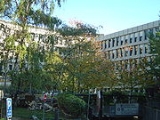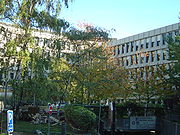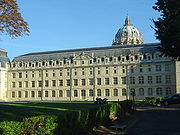
Val-de-Grâce
Encyclopedia
This article describes the hospital and former abbey. For the main article on Mansart and Lemercier's central church, see Church of the Val-de-Grâce
.

 The Val-de-Grâce (Hôpital d'instruction des armées du Val-de-Grâce or HIA Val-de-Grâce) is a military hospital
The Val-de-Grâce (Hôpital d'instruction des armées du Val-de-Grâce or HIA Val-de-Grâce) is a military hospital
located in the 5th arrondissement
of Paris
, France
.
(48°50′26"N 2°20′31"E) was built by order of Queen Anne of Austria
, wife of Louis XIII
. After the birth of her son Louis XIV
, Anne (previously childless after 23 years of marriage) showed her gratitude to the Virgin Mary by building a church on the land of a Benedictine
convent
. Louis XIV himself is said to have laid the cornerstone for the Val-de-Grâce in a ceremony that took place April 1, 1645, when he was seven years old.
The church of the Val-de-Grâce, designed by François Mansart
and Jacques Lemercier
, is considered by some as Paris's best example of baroque architecture (curving lines, elaborate ornamentation and harmony of different elements). Construction began in 1645, and was completed in 1667.
The Benedictine nuns provided medical care for injured revolutionaries during the French Revolution
, and thus the church at Val-de-Grace was spared much of the desecration
and vandalism that plagued other, more famous Paris churches (Notre Dame was looted and turned into a warehouse; St. Eustache was used as a barn, for example). As a result, the church's exquisite interior is one of the few unspoiled remnants of Paris's pre-Revolution grandeur. Following the Revolution, the buildings were converted into a military hospital.
Currently, the original buildings only serve for offices and teaching facilities (École d'application du Service de santé des armées); the actual medical facilities are inside a large modern building to the east on the same grounds.
The present-day hospital was built in the 1970s and completed in 1979. It has a capacity of 350 beds, in various specialties. The hospital is accessible to military personnel in need of medical aid as well as to any person with health coverage under the French social security
system. It is famous for being the place where the top officials of the French Republic generally get treated for ailment.
The statue standing in the courtyard is that of Dominique Jean Larrey
(as sculpted by David d'Angers in 1843), who was Napoleon's personal surgeon and innovator of the concept of battlefield triage
.
The old abbey
alongside the church is now a museum of French army medicine. Tours of the museum and church are available for a small fee (being a military facility, the grounds are under military guard and tourists are escorted). Cameras are not permitted except for inside the church itself.
The last emperor of Vietnam
Bảo Đại
died at Val-de-Grâce hospital on July 30, 1997, age 83.
, cadet of the House of Bourbon
;
, Louis Aragon
and André Breton
, surrealist
artists, were enlisted as physicians-in-training at the hospital. As a part of the French government's efforts to keep morale up during the war, a museum of reconstructive surgery
was built in the hospital. The exhibits consisted of wax sculptures of deformed human faces and the results of reconstructive surgery. A look at the museum reveals that there is almost no doubt that the exhibits had an impact on the two artists and eventually the surrealist movement, which frequently deals with themes of dismemberment
and disfiguration.
Church of the Val-de-Grâce
This article describes the church of the Val-de-Grâce. For the surrounding hospital and former abbey, see Val-de-Grâce.The Church of the Val-de-Grâce is the church of a former royal abbey in the 5th arrondissement of Paris, in what is now the Val-de-Grâce Hospital. The dome of the church is a...
.


Military hospital
Military hospital is a hospital, which is generally located on a military base and is reserved for the use of military personnel, their dependents or other authorized users....
located in the 5th arrondissement
Ve arrondissement
The 5th arrondissement of Paris is one of the 20 arrondissements of the capital city of France.Situated on the left bank of the River Seine, it is one of the central arrondissements of the capital...
of Paris
Paris
Paris is the capital and largest city in France, situated on the river Seine, in northern France, at the heart of the Île-de-France region...
, France
France
The French Republic , The French Republic , The French Republic , (commonly known as France , is a unitary semi-presidential republic in Western Europe with several overseas territories and islands located on other continents and in the Indian, Pacific, and Atlantic oceans. Metropolitan France...
.
History
The church of the Val-de-GrâceChurch of the Val-de-Grâce
This article describes the church of the Val-de-Grâce. For the surrounding hospital and former abbey, see Val-de-Grâce.The Church of the Val-de-Grâce is the church of a former royal abbey in the 5th arrondissement of Paris, in what is now the Val-de-Grâce Hospital. The dome of the church is a...
(48°50′26"N 2°20′31"E) was built by order of Queen Anne of Austria
Anne of Austria
Anne of Austria was Queen consort of France and Navarre, regent for her son, Louis XIV of France, and a Spanish Infanta by birth...
, wife of Louis XIII
Louis XIII of France
Louis XIII was a Bourbon monarch who ruled as King of France and of Navarre from 1610 to 1643.Louis was only eight years old when he succeeded his father. His mother, Marie de Medici, acted as regent during Louis' minority...
. After the birth of her son Louis XIV
Louis XIV of France
Louis XIV , known as Louis the Great or the Sun King , was a Bourbon monarch who ruled as King of France and Navarre. His reign, from 1643 to his death in 1715, began at the age of four and lasted seventy-two years, three months, and eighteen days...
, Anne (previously childless after 23 years of marriage) showed her gratitude to the Virgin Mary by building a church on the land of a Benedictine
Benedictine
Benedictine refers to the spirituality and consecrated life in accordance with the Rule of St Benedict, written by Benedict of Nursia in the sixth century for the cenobitic communities he founded in central Italy. The most notable of these is Monte Cassino, the first monastery founded by Benedict...
convent
Convent
A convent is either a community of priests, religious brothers, religious sisters, or nuns, or the building used by the community, particularly in the Roman Catholic Church and in the Anglican Communion...
. Louis XIV himself is said to have laid the cornerstone for the Val-de-Grâce in a ceremony that took place April 1, 1645, when he was seven years old.
The church of the Val-de-Grâce, designed by François Mansart
François Mansart
François Mansart was a French architect credited with introducing classicism into Baroque architecture of France...
and Jacques Lemercier
Jacques Lemercier
Jacques Lemercier was a French architect and engineer, one of the influential trio that included Louis Le Vau and François Mansart who formed the classicizing French Baroque manner, drawing from French traditions of the previous century and current Roman practice the fresh, essentially French...
, is considered by some as Paris's best example of baroque architecture (curving lines, elaborate ornamentation and harmony of different elements). Construction began in 1645, and was completed in 1667.
The Benedictine nuns provided medical care for injured revolutionaries during the French Revolution
French Revolution
The French Revolution , sometimes distinguished as the 'Great French Revolution' , was a period of radical social and political upheaval in France and Europe. The absolute monarchy that had ruled France for centuries collapsed in three years...
, and thus the church at Val-de-Grace was spared much of the desecration
Desecration
Desecration is the act of depriving something of its sacred character, or the disrespectful or contemptuous treatment of that which is held to be sacred or holy by a group or individual.-Detail:...
and vandalism that plagued other, more famous Paris churches (Notre Dame was looted and turned into a warehouse; St. Eustache was used as a barn, for example). As a result, the church's exquisite interior is one of the few unspoiled remnants of Paris's pre-Revolution grandeur. Following the Revolution, the buildings were converted into a military hospital.
Currently, the original buildings only serve for offices and teaching facilities (École d'application du Service de santé des armées); the actual medical facilities are inside a large modern building to the east on the same grounds.
The present-day hospital was built in the 1970s and completed in 1979. It has a capacity of 350 beds, in various specialties. The hospital is accessible to military personnel in need of medical aid as well as to any person with health coverage under the French social security
Social security
Social security is primarily a social insurance program providing social protection or protection against socially recognized conditions, including poverty, old age, disability, unemployment and others. Social security may refer to:...
system. It is famous for being the place where the top officials of the French Republic generally get treated for ailment.
The statue standing in the courtyard is that of Dominique Jean Larrey
Dominique Jean Larrey
Dominique Jean Larrey was a French surgeon in Napoleon's army and an important innovator in battlefield medicine.-Biography:...
(as sculpted by David d'Angers in 1843), who was Napoleon's personal surgeon and innovator of the concept of battlefield triage
Triage
Triage or ) is the process of determining the priority of patients' treatments based on the severity of their condition. This rations patient treatment efficiently when resources are insufficient for all to be treated immediately. The term comes from the French verb trier, meaning to separate,...
.
The old abbey
Abbey
An abbey is a Catholic monastery or convent, under the authority of an Abbot or an Abbess, who serves as the spiritual father or mother of the community.The term can also refer to an establishment which has long ceased to function as an abbey,...
alongside the church is now a museum of French army medicine. Tours of the museum and church are available for a small fee (being a military facility, the grounds are under military guard and tourists are escorted). Cameras are not permitted except for inside the church itself.
The last emperor of Vietnam
South Vietnam
South Vietnam was a state which governed southern Vietnam until 1975. It received international recognition in 1950 as the "State of Vietnam" and later as the "Republic of Vietnam" . Its capital was Saigon...
Bảo Đại
Bảo Đài
Bảo Đài is a commune and village in Lục Nam District, Bac Giang Province, in northeastern Vietnam.-References:...
died at Val-de-Grâce hospital on July 30, 1997, age 83.
People buried at Val-de-Grâce
Val-de-Grâce was later the traditional burial place for members of the House of OrléansHouse of Orleans
Orléans is the name used by several branches of the Royal House of France, all descended in the legitimate male line from the dynasty's founder, Hugh Capet. It became a tradition during France's ancien régime for the duchy of Orléans to be granted as an appanage to a younger son of the king...
, cadet of the House of Bourbon
House of Bourbon
The House of Bourbon is a European royal house, a branch of the Capetian dynasty . Bourbon kings first ruled Navarre and France in the 16th century. By the 18th century, members of the Bourbon dynasty also held thrones in Spain, Naples, Sicily, and Parma...
;
- Mademoiselle de Valois (1693-1694) daughter of Philippe d'OrléansPhilippe II, Duke of OrléansPhilippe d'Orléans was a member of the royal family of France and served as Regent of the Kingdom from 1715 to 1723. Born at his father's palace at Saint-Cloud, he was known from birth under the title of Duke of Chartres...
; - Louis d'Orléans
- Margravine Auguste Marie Johanna of Baden-BadenMargravine Auguste Marie Johanna of Baden-BadenJohanna of Baden-Baden was born a Margravine of Baden-Baden, she was the Duchess of Orléans by marriage to Louis d'Orléans, Duke of Orléans. Her husband was a grandson of her father's former enemy Louis XIV of France. Known in France as Jeanne de Bade, she died in childbirth...
, duchesse d'Orléans (1704-1726); - Louise Marie d'OrléansLouise Marie d'OrléansLouise Marie d'Orléans was a French princess by birth.-Biography:Louise Marie d'Orléans was born at the Palais-Royal to Louis d'Orléans, Duke of Orléans and his Duchess, the Margravine Johanna of Baden-Baden, who died three days after giving birth.Her father was a second cousin of the then King...
, Mademoiselle (1726-1728), daughter of the above who died in childbirth giving birth to Louise Marie; - Louis Philippe d'OrléansLouis Philippe I, Duke of OrléansLouis Philippe d'Orléans known as le Gros , was a French nobleman, a member of a cadet branch of the House of Bourbon, the dynasty then ruling France. The First Prince of the Blood after 1752, he was the most senior male at the French court after the immediate royal family. He was the father of...
(1725-1785) son of Louis; - Louise Henriette de Bourbon (1726-1759) wife of the above
Impact on the arts
During World War IWorld War I
World War I , which was predominantly called the World War or the Great War from its occurrence until 1939, and the First World War or World War I thereafter, was a major war centred in Europe that began on 28 July 1914 and lasted until 11 November 1918...
, Louis Aragon
Louis Aragon
Louis Aragon , was a French poet, novelist and editor, a long-time member of the Communist Party and a member of the Académie Goncourt.- Early life :...
and André Breton
André Breton
André Breton was a French writer and poet. He is known best as the founder of Surrealism. His writings include the first Surrealist Manifesto of 1924, in which he defined surrealism as "pure psychic automatism"....
, surrealist
Surrealism
Surrealism is a cultural movement that began in the early 1920s, and is best known for the visual artworks and writings of the group members....
artists, were enlisted as physicians-in-training at the hospital. As a part of the French government's efforts to keep morale up during the war, a museum of reconstructive surgery
Surgery
Surgery is an ancient medical specialty that uses operative manual and instrumental techniques on a patient to investigate and/or treat a pathological condition such as disease or injury, or to help improve bodily function or appearance.An act of performing surgery may be called a surgical...
was built in the hospital. The exhibits consisted of wax sculptures of deformed human faces and the results of reconstructive surgery. A look at the museum reveals that there is almost no doubt that the exhibits had an impact on the two artists and eventually the surrealist movement, which frequently deals with themes of dismemberment
Dismemberment
Dismemberment is the act of cutting, tearing, pulling, wrenching or otherwise removing, the limbs of a living thing. It may be practiced upon human beings as a form of capital punishment, as a result of a traumatic accident, or in connection with murder, suicide, or cannibalism...
and disfiguration.

